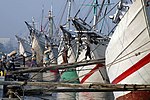The Regatta Jakarta
The Regatta is a mixed development complex of 11 skyscrapers overlooking the Java Sea at Pluit, Jakarta, Indonesia. The complex has a land area of about 11 hectares. There is a 2.4 hectares aqua park within the complex.The tallest of the towers is a hotel building, which is 163 meters tall and 40 floors above the ground. The concept of the development follows a nautical theme, the centerpiece of which being an aerodynamically shaped hotel overlooking the Java Sea with chic lines is a series of 10 apartment towers of same design, symbolizing of tall ships sailing around the ‘lighthouse’ represented by the hotel, which gave to the name ‘Regatta’. The development won FIABCI (International Real Estate Federation) Prix d'Excellence Awards in 2010.All apartment towers are named after major port cities of the world and are each orientated towards the cardinal direction of their corresponding city.
Excerpt from the Wikipedia article The Regatta Jakarta (License: CC BY-SA 3.0, Authors).The Regatta Jakarta
Special Capital Region of Jakarta Penjaringan (North Jakarta)
Geographical coordinates (GPS) Address Nearby Places Show on map
Geographical coordinates (GPS)
| Latitude | Longitude |
|---|---|
| N -6.095343 ° | E 106.792192 ° |
Address
14440 Special Capital Region of Jakarta, Penjaringan (North Jakarta)
Indonesia
Open on Google Maps








